87% of mobile marketers are not ready for Apple’s SKAdNetwork and a post-IDFA future
The good news: almost 60% of marketers have a plan to implement Apple’s SKAdNetwork framework for app install measurement.
The bad news: most haven’t implemented or tested it.
According to a recent survey of 267 mobile publishers, game studios, and companies that deliver services via mobile apps, most are not yet ready for Apple’s massive IDFA changes. They’re not fully up to speed on SKAdNetwork, Apple’s framework for deterministically measuring ad-driven app installs in a privacy-safe way. And they have not tested measuring app installs from beginning to end with their ad networks to ensure they can track ad performance in a world without any guarantees for the availability of device identifiers.
Plus, only 34% have implemented SKAdNetwork install notifications as part of their apps.
And only 13.5% are fully ready for a future without the IDFA.
For the past few weeks, Singular has been conducting a post-IDFA readiness evaluation for any company that wants to assess its ability to measure mobile app install campaigns when Apple’s iOS 14 privacy protections are fully implemented. That’s likely to be very early this year, and it means that IDFA-based mobile measurement on iOS is going to be significantly impaired in favor of Apple’s privacy-safe SKAdNetwork measurement framework. Hundreds of marketers have participated, including people from some of the biggest mobile games publishers on the planet, some of the largest social networks globally, and some of the biggest on-demand providers in the United States.
We asked six simple questions.
Here are the responses.
Do you have a plan?
The first question is the most basic: Do you have a plan for implementing SKAdNetwork, including postback and conversion management?
58% of marketers do have a plan.
42%, however, do not yet have a plan for how they will implement SKAdNetwork, measure app installs, capture postbacks, and manage conversions.
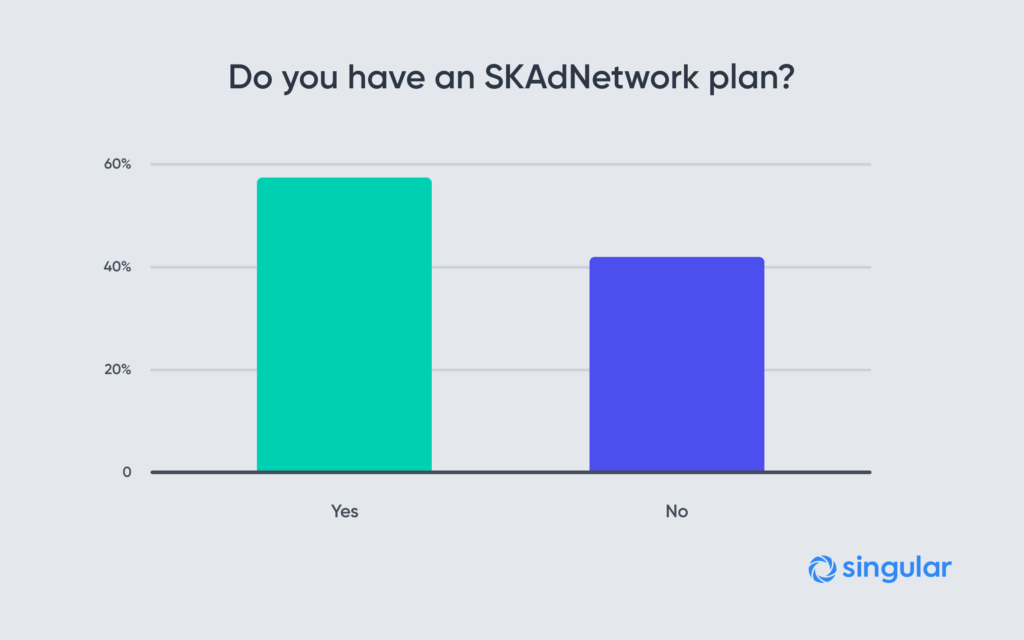
Have you started implementing SKAdNetwork postbacks?
Having a plan is step one. Step two is starting to implement that plan, and the first part of step two is instrumenting your app to send SKAdNetwork postbacks.
Our question: Have you implemented SKAdNetwork basic install notifications as part of your app?
This is literally the most basic and essential step in implementing SKAdNetwork, and is absolutely critical for any mobile marketer who is serious about growth on iPhone and iPad in the iOS 14 and beyond era. Without postbacks being sent to your ad network and MMP, mobile measurement is extremely challenging at best, and potentially impossible at worst.
But only 34% have implemented SKAdNetwork postbacks.
In spite of their plans, 66% have not.
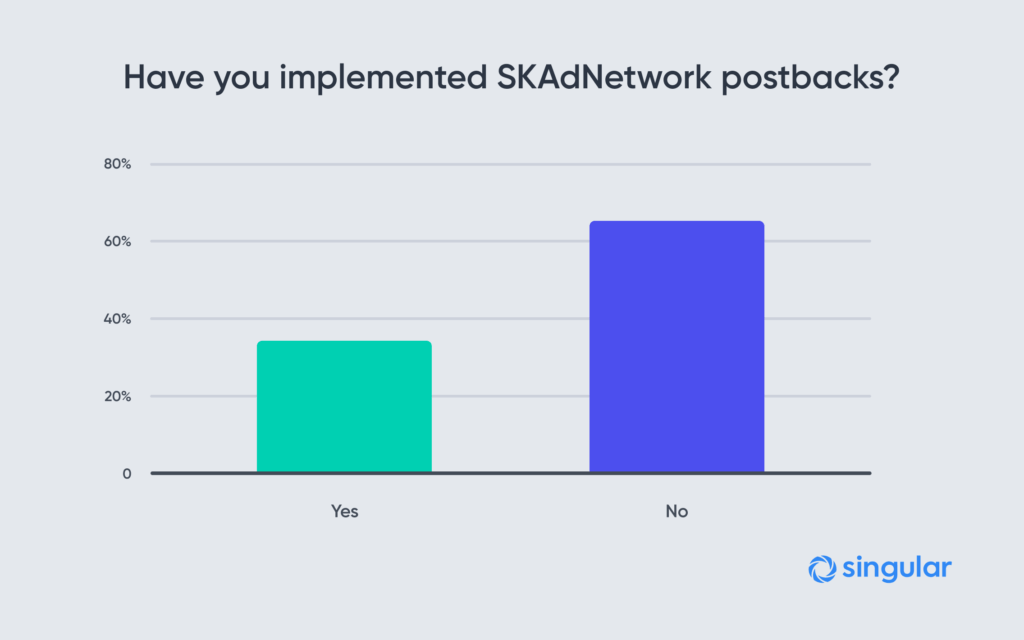
Are you testing with ad networks?
Once you’ve implemented postbacks in SKAdNetwork, the next step is actually testing them in a live or demo environment. In an ideal world, this might not be necessary, but in the real world, there’s often a significant difference between theory and practice.
So question three is about testing: Are you testing SKAdNetwork end-to-end with an ad network to ensure postbacks are being sent and received properly?
Unfortunately, an overwhelming majority of mobile marketers — almost 70% — are not yet testing their implementations … so even some of the 34% who have implemented postbacks are not yet running them through real-world situations and ensuring they can measure the results of their mobile marketing campaigns post-IDFA.
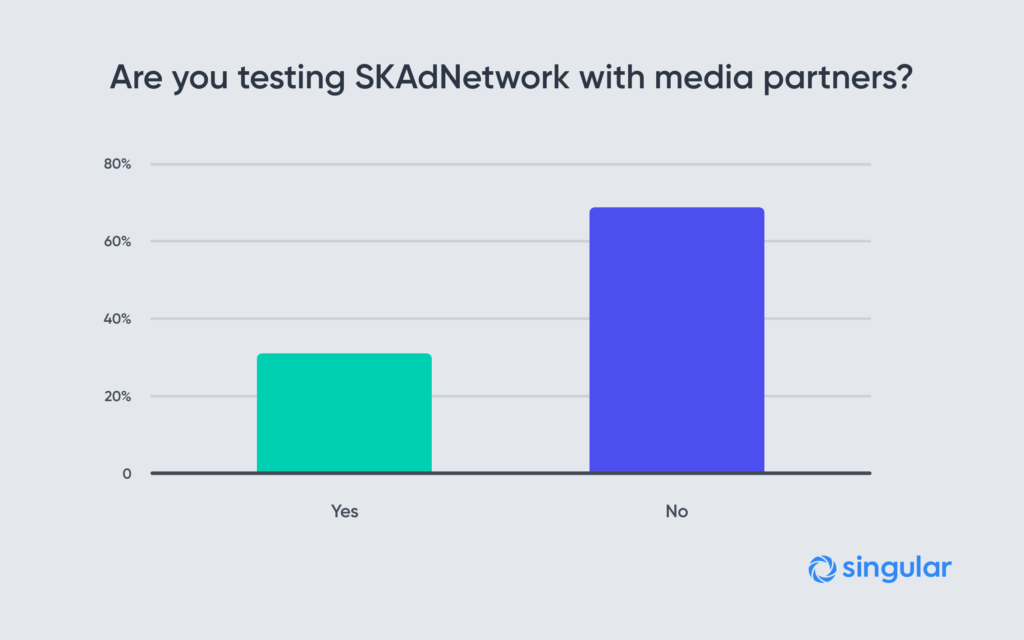
Do you know how to define a conversion model and KPIs?
The news is a bit better when it comes to conversion models and KPIs.
Conversion models are how you can report the likely value of an install, and include data around things like engagement, step completion, purchases, and so on, that can be included in an SKAdNetwork postback. We already saw that almost 60% of marketers have a plan for SKAdNetwork. Judging by the answers to this question, they’ve also taken some time to work on communicating post-install conversion events or signals via their SKAdNetwork postbacks.
Question four is: Do you know how to define your conversion model to ensure you can report on the metrics you care about?
51% do.
49% do not.
Note: this is only the second question which the majority of mobile marketers answered in the affirmative. For all the other questions, most mobile marketers aren’t ready for SKAdNetwork yet. And, of course, this question only asks whether marketers know how to define a conversion model in SKAdNetwork … not whether they actually have yet.
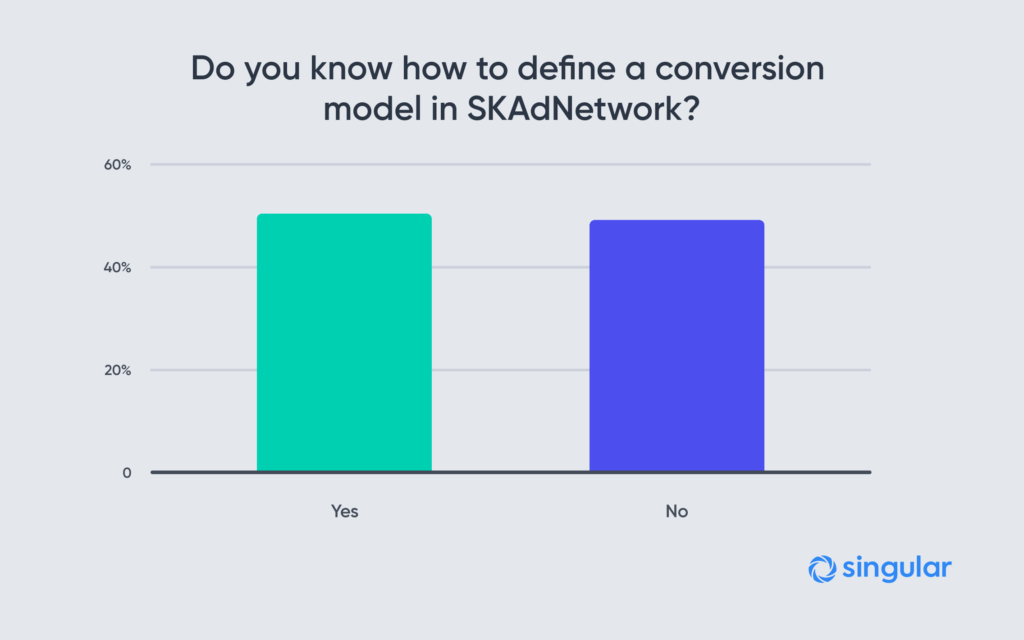
Do you have a conversion management solution?
Having a model for conversion management in SKAdNetwork is great. Being able to apply it in your app is better. But having the power to switch models instantly when needed, or use software to instantly know how your result might change with different conversion models, that’s best.
Unfortunately, most marketers don’t have anything like that in place.
So question five is about conversion management: Do you have a solution for updating your conversion model without code changes and re-submitting your app?
This is important because in SKAdNetwork, marketers get signals that they can use to optimize their app install advertising only once, a minimum of 24 hours after app install, and only with six bits of data on post-install events, engagements, or conversions. Getting post-install data is critical to knowing whether an ad campaign worked, whether a new ad network partner is good, or whether the new channel you’re using is effective. When analyzing that post-install data, it might prove most effective to look at engagement or use of your app. Alternatively, it might be best to look at purchases, or sign-ups, or level completions. Perhaps retention or use over multiple days is best. Or maybe the amount of time people spend in your app is a stronger predictive signal of future value.
So being able to swap conversion methodologies at will is powerful.
While many seem to have a plan in place for defining their conversion models, they don’t have the technology or process to do so. Being able to model performance using different conversion methodologies without actually having to switch — to check if certain media partners or ad campaigns or creative are stronger than they appeared at first — is essential because iOS 14 and SKAdNetwork is such a foundational shift in mobile marketing on Apple devices. It’s very unlikely that everything will work exactly the way you anticipate on day one of the new reality, so you need to be able to shift on the fly and not wait for your app to go through an update cycle before testing new conversion management and measurement solutions.
(For a complete overview of how to do that, check this excellent and detailed guide to predictive LTV in iOS 14 and SKAdNetwork).
So question five is about conversion management: Do you have a solution for updating your conversion model without code changes and re-submitting your app?
The reality is: most can’t. 64% of marketers can’t dynamically switch conversion models in real-time, while 36% can.
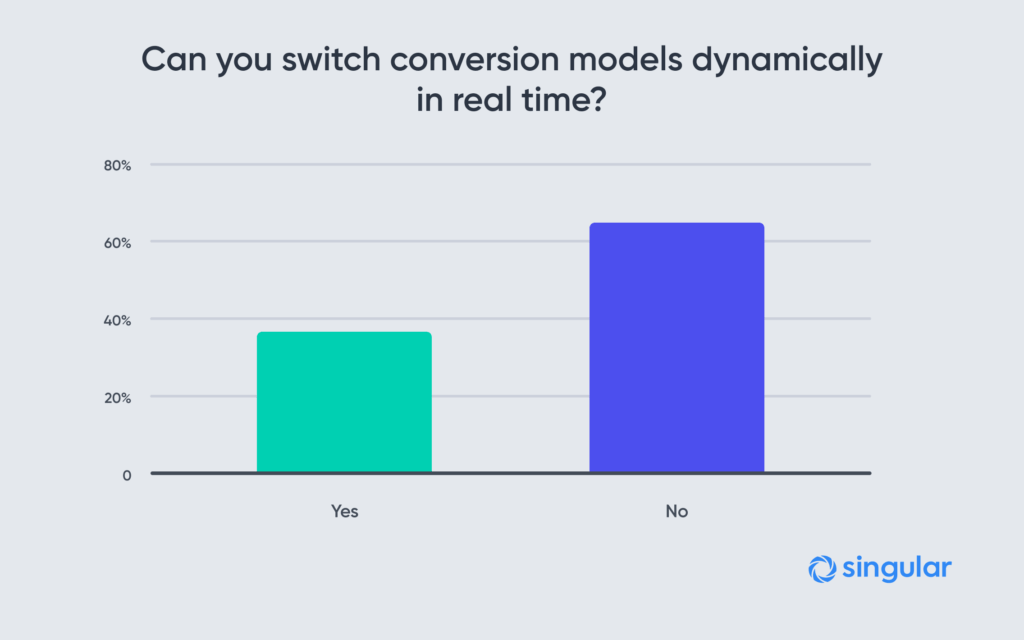
Can you manage all your SKAdNetwork conversion data in one place?
Finally, we asked mobile marketers if they can manage all their SKAdNetwork data in one place.
By default, Apple’s SKAdNetwork framework sends conversion postbacks only to the ad network that placed an ad that resulted in a click and a subsequent app install. Since most mobile marketers manage campaigns with multiple ad networks, and marketers with scale can easily find themselves running campaigns with dozens of media partners, that’s a problem.
Plus, Facebook strongly recommends advertisers use an MMP for SKAdNetwork attribution management to ensure conversion methodology consistency across partners.
Just like all your other marketing data, you need a single source of truth to know:
- How much you’re spending
- What’s working
- Which partners are driving the most growth
- Which campaigns are most effective
- What your overall return on ad spend (ROAS) is
- And much more …
Hence, question six on analytics and ROAS: Do you have a solution for centralizing SKAdNetwork conversion data and tying it to ad spend?
Unfortunately, 63% of marketers do not have a solution in place. Only 37% do.
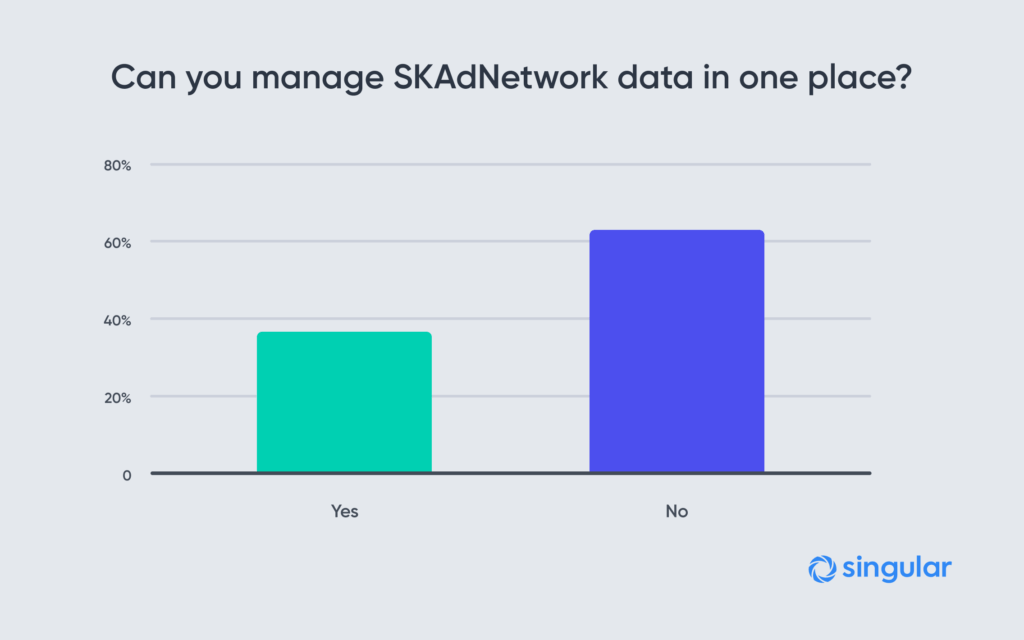
Summing up: Almost 90% of marketers are not fully ready for SKAdNetwork
86.5% of marketers who self-evaluated their SKAdNetwork progress answered with at least one “no” to the six questions. Only 13.5% were able to answer yes in all of the critical areas where performance marketers looking to drive app install growth need to be prepared.
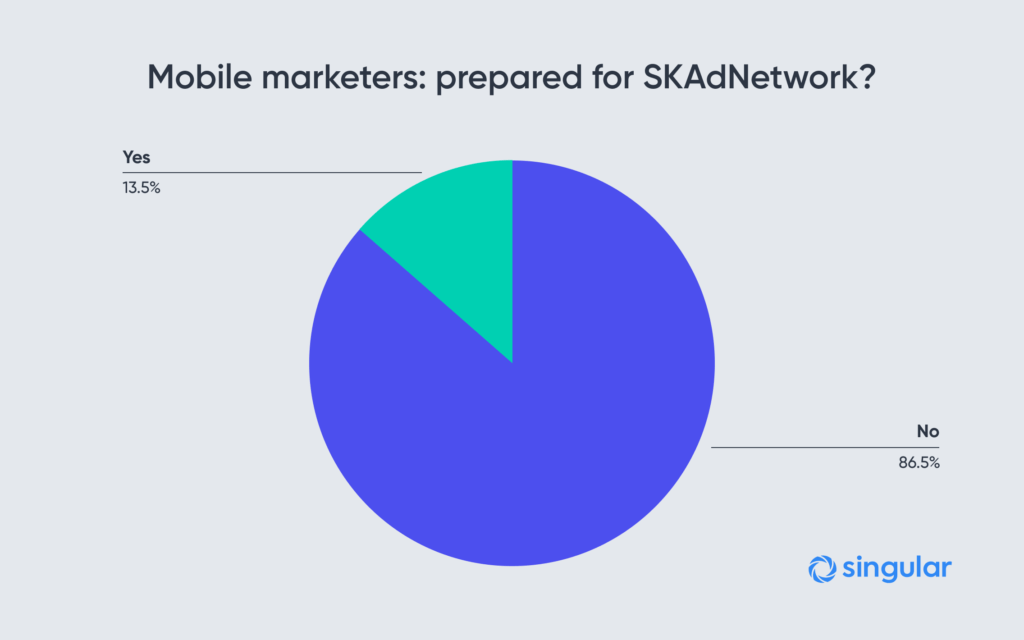
Of course, this is a limited sample size.
Keep in mind, however, that these are the marketers who are aware enough about SKAdNetwork, IDFA, and iOS 14’s new privacy technologies to be taking an evaluation quiz in the first place. While there’s probably a population of mobile marketers who have everything figured out and are on top of every last detail, there’s probably also a population who have not really troubled to get very deep at all into the coming changes, and will still be caught by surprise when they happen.
My advice: don’t let yourself be one of them.
And review Singular’s full SKAdNetwork solution which will demystify the new iOS attribution reality and help you implement it with a complete minimum of fuss. Also, take the post-IDFA readiness evaluation yourself, and we’ll give you feedback in a downloadable readiness checklist that will help you ensure you’re covering all your bases.
Stay up to date on the latest happenings in digital marketing


